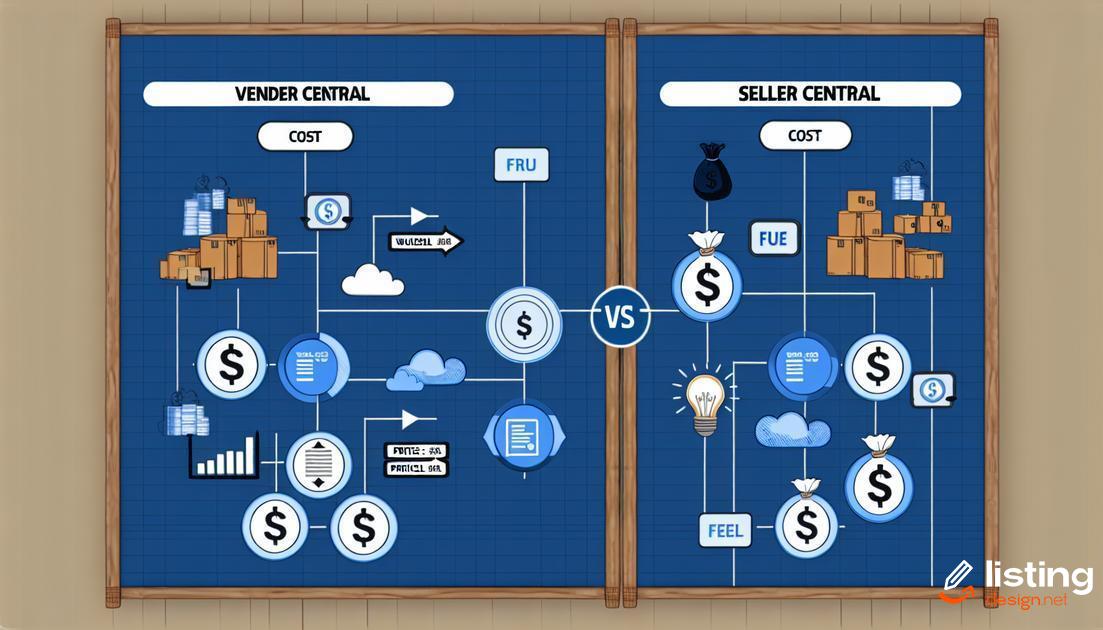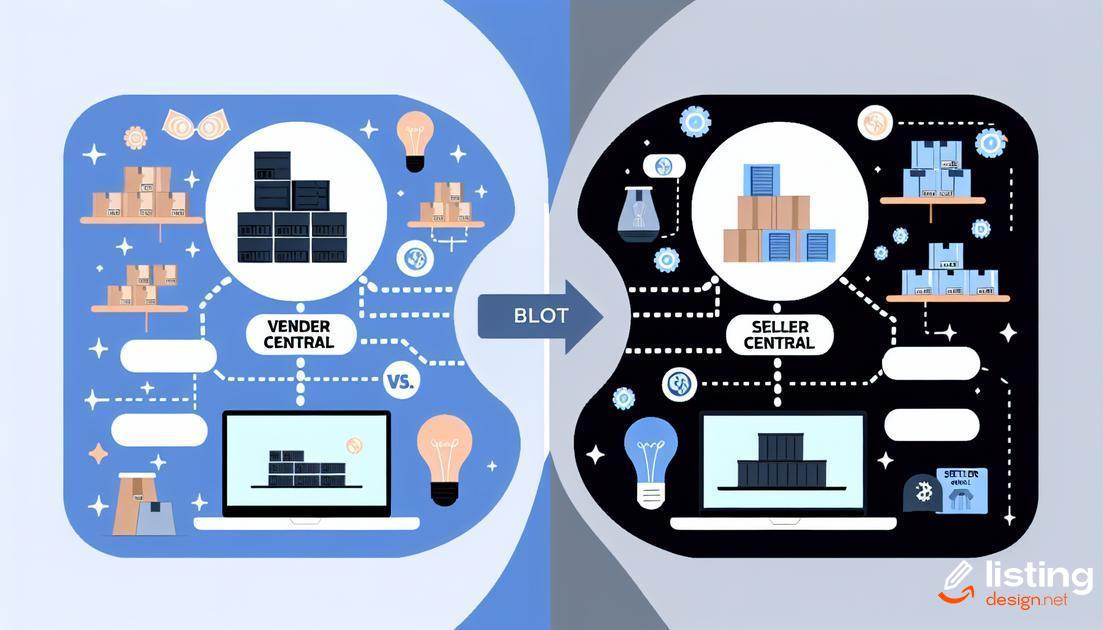Are you trying to decide between Vendor Central and Seller Central for your business? Choosing the right platform is crucial for your success. In this article, we’ll break down the key differences, benefits, and potential drawbacks of Vendor Central and Seller Central. This comparison helps you make an informed decision suitable for your business needs.
Table of Contents
Understanding Vendor Central
Vendor Central is the invite-only platform where manufacturers and distributors sell their products directly to Amazon in bulk. This mode of operation typically suits large manufacturers and brands with a robust supply chain infrastructure. One of the main benefits of Vendor Central is that Amazon handles all the logistics—from storage to shipping—and customer service, which can be a significant advantage for businesses that may not have the infrastructure to manage these aspects independently.
In Vendor Central, once Amazon purchases your products, they gain control over pricing, promotions, and product listings. This can be beneficial in capturing a wide market through Amazon’s vast resources, but it also means losing some control over how your products are marketed and priced. Moreover, as a vendor, you may have enhanced marketing opportunities through features such as A+ Content and Amazon Vine reviews, which can help in driving higher conversion rates and increasing brand visibility.
In terms of fulfillment, Vendor Central benefits from Amazon’s advanced logistics network. Your products are eligible for Amazon Prime, which can boost sales by offering rapid delivery options. However, this comes at a cost, and Amazon’s payment terms can often be longer than other sales platforms, affecting cash flow for your business. Additionally, because Amazon controls the retail price, profit margins can sometimes be lower than expected due to Amazon’s competitive pricing strategies.
Another key advantage is that Vendor Central provides an opportunity to benefit from Amazon’s power in search and merchandising. Amazon’s algorithm often prioritizes products sold directly by Amazon, leading to better placement in search results and higher visibility. This can be particularly valuable for well-established brands looking to expand their reach and capitalize on Amazon’s extensive customer base.
Understanding Seller Central

In Seller Central, businesses gain full control over their sales, unlike Vendor Central where Amazon purchases products directly from suppliers. This platform is designed for third-party sellers who list products on the Amazon marketplace themselves. Sellers handle pricing, inventory, and shipping, offering a dynamic yet comprehensive retail environment.
Managing an Amazon Seller Central account requires understanding fees, such as referral fees and variable closing fees. Handling customer service is a vital aspect where sellers interact directly with buyers.
Product listing optimization is crucial in Seller Central. Sellers need to focus on keyword-rich descriptions and high-quality images to stand out. Tools for marketing, such as sponsored ads, help businesses gain visibility and drive sales.
Seller Central offers extensive data analytics & tools that help businesses monitor performance, track key metrics, and adjust strategies to improve sales.
Key Differences Between Vendor Central and Seller Central
Purchase Orders vs. Direct Sales:
One of the primary differences between Vendor Central and Seller Central is how transactions are managed. Vendor Central operates on a wholesale model where Amazon purchases products directly from the vendor. The vendor then fulfills these bulk purchase orders. In contrast, Seller Central allows sellers to list products directly on Amazon’s marketplace. Sales are made directly to consumers, with sellers managing their own inventory and shipments.
Control Over Pricing:
In Vendor Central, Amazon sets the retail price, which can fluctuate based on demand and competition. Sellers have limited control over these prices. Conversely, Seller Central enables sellers to retain full control over their product pricing, allowing them to adjust based on market conditions and profit margins.
Inventory Management:
With Vendor Central, Amazon takes on the responsibility of stock management, including storage and logistics. Vendors are primarily focused on supplying products as needed. Seller Central requires sellers to manage their own inventory levels, whether through Amazon’s Fulfillment by Amazon (FBA) service or by handling fulfillment independently.
Marketing and Promotion:
Both platforms offer various tools for promotions and marketing. However, Vendor Central vendors may have access to more sophisticated marketing opportunities and Amazon Marketing Services (AMS). Seller Central provides access to basic advertising tools, like Sponsored Products and Sponsored Brands. Each platform’s marketing potential varies depending on the seller’s goals and resources.
Understanding these key differences can help businesses decide which platform aligns best with their operational capacities and strategic goals.
Pros and Cons of Vendor Central

Pros of Vendor Central
,Access to Amazon’s Retail Team: By using Vendor Central, you get access to Amazon’s retail team, which can help you manage inventory and boost your sales.,Increased Credibility: Being a vendor on Amazon can increase your brand’s credibility as your products will be listed as ‘Ships from and sold by Amazon.com’.,Higher Purchase Orders: Vendors often receive larger purchase orders from Amazon, leading to higher sales volumes.,Automated Logistics: Amazon handles most of the logistics, including shipping and customer service, freeing up your time to focus on other aspects of your business.,
Cons of Vendor Central
,Lower Profit Margins: Amazon typically purchases products at wholesale prices, which can lead to lower profit margins compared to selling directly to customers.,Less Control: Vendors have less control over pricing and listing details. Amazon sets the price and controls most aspects of the product listing.,Complexity in Operations: Managing purchase orders, inventory, and logistics can become complex and require significant resources.,Payment Terms: Amazon’s payment terms to vendors may not be as favorable, often involving longer payment cycles which can impact cash flow.
Pros and Cons of Seller Central
Pros of Seller Central:
- Greater Control: Businesses maintain more control over their listings, pricing, and inventory. This flexibility allows for quick adjustments and responses to market changes.
- Faster Payments: Amazon disburses payments every two weeks, offering quicker access to funds compared to Vendor Central.
- Brand Registry: Sellers can register their brand with Amazon Brand Registry, providing better tools to protect their brand and improve product visibility.
- Direct Customer Interaction: Sellers handle customer service directly, allowing them to build stronger relationships and address issues promptly.
Cons of Seller Central:
- More Responsibility: With greater control comes more responsibility. Sellers manage their own inventory, orders, and customer service, which can be time-consuming and requires more effort.
- Competition: The platform is highly competitive as sellers are directly competing with other third-party sellers and even Amazon itself.
- Marketing and Advertising Costs: Sellers often need to invest in Amazon’s PPC (Pay-Per-Click) campaigns to gain visibility, which can add to overall costs.
- Complexity: Navigating Seller Central’s tools and features can be complex for new sellers, requiring a steep learning curve.
Cost Differences Between Vendor and Seller Central

One significant factor when choosing between Vendor Central and Seller Central is the cost structure. These two platforms have different fee models, which can impact your overall profitability.
Vendor Central Costs
In Vendor Central, you’re essentially selling products to Amazon at wholesale prices. This model means there are no direct selling fees, but Amazon will likely expect a considerable discount. Additionally, certain costs such as marketing co-op fees, freight allowance, and other vendor agreements can add up.
Seller Central Costs
Seller Central operates more like a traditional marketplace where you manage your own listings. Here, you will encounter different types of costs including referral fees, which typically range between 6% to 45% depending on the product category. You will also have a monthly subscription fee if you opt for a Professional account, and other costs like fulfillment by Amazon (FBA) fees if you choose to use Amazon’s logistics network.
Understanding the cost structures is crucial to determine which platform aligns with your business model and financial strategy. Consider all possible expenses to make an informed decision between Vendor Central and Seller Central.
Control and Ownership in Vendor vs. Seller Central
The distinction between control and ownership is a pivotal factor when comparing Vendor Central and Seller Central. In Vendor Central, Amazon operates as the retailer, purchasing products directly from manufacturers and reselling them on the platform. This results in manufacturers having less control over pricing and inventory management. Conversely, Seller Central allows merchants to maintain full ownership of their products and listings. Sellers set their own prices, manage inventory, and have access to Amazon’s vast customer base. However, this increased control comes with heightened responsibilities such as adhering to fulfillment standards and managing customer service. Understanding the nuances of each model helps businesses choose the optimal platform according to their strategic goals.
Marketing Opportunities on Vendor Central

Exploring the marketing opportunities on Vendor Central can provide significant advantages for brands looking to leverage Amazon’s vast customer base. By partnering with Amazon as a vendor, businesses gain access to enhanced marketing tools and programs that are tailored to maximize product visibility and sales.
The Subscribe & Save program is one such tool, enabling recurring purchases by offering discounts for regular shipments, thus increasing customer retention and loyalty. Additionally, vendors can benefit from Amazon’s A+ Content, which allows rich product descriptions that can include high-quality images, videos, and comparative charts to engage potential buyers more effectively.
Another standout feature is the Amazon Vine program, where selected reviewers get early access to new products in exchange for their reviews. This can significantly boost a product’s credibility and enhance its ranking in search results.
Vendors also have the advantage of accessing exclusive ad placements such as Headline Search Ads and Product Display Ads, which appear in high-visibility areas across Amazon’s platform. These targeted ad types can help drive more traffic to a brand’s products and increase conversion rates.
Amazon Marketing Services (AMS)
provides numerous options for vendors to create sponsored product ads, which can be strategically placed to appear in search results or on competitors’ product pages. The analytics and reporting tools available within AMS also offer valuable insights into campaign performance, allowing for continual optimization of marketing strategies.
Lastly, being a vendor means having the support of Amazon’s dedicated account managers who can provide guidance on maximizing these marketing opportunities, ensuring that your products receive the attention they deserve in a competitive marketplace.
Marketing Opportunities on Seller Central
Seller Central offers a multitude of marketing opportunities tailored to empower businesses to enhance their visibility and boost sales on Amazon’s marketplace. One of the most powerful tools available is Sponsored Products. These PPC (pay-per-click) ads allow sellers to promote individual listings directly on search results and product detail pages, driving targeted traffic to their products.
Sponsored Brands are another effective option. These ads feature a custom headline, logo, and multiple products, and are typically displayed above search results, helping to boost brand recognition.
Additionally, sellers can utilize Amazon Stores to create a curated, multi-page shopping experience that showcases their brand and products. This feature allows for a more cohesive branding strategy.
For those looking to engage customers with high-quality content, the Amazon Posts feature provides a platform for sharing lifestyle images and stories associated with their products. This helps in building a community and keeping customers engaged.
Moreover, using Lightning Deals and Coupons can significantly increase visibility and urgency, encouraging faster purchasing decisions. These time-sensitive promotions often appear on Amazon’s Today’s Deals page, attracting a large number of deal-seeking shoppers.
Finally, leveraging the Amazon Brand Analytics tool can provide sellers with valuable insights into customer behavior and preferences. This data helps in refining marketing strategies and making data-driven decisions to enhance overall performance.
Which Platform Suits Small Businesses?

Small businesses have unique needs that differ from larger enterprises, especially when considering e-commerce platforms. Choosing the right platform can significantly impact their growth potential and operational efficiency. One of the main factors to consider is the level of control and flexibility offered by the platform.
Vendor Central
can be advantageous for businesses looking for a more hands-off approach, as Amazon takes care of most of the logistics, including marketing and customer service. However, it requires larger bulk orders and offers less direct control over pricing and inventory. This may not align well with small businesses that need more agility and direct oversight.
Seller Central
is often preferred by small businesses because it provides greater control over product listings, pricing, and inventory. This platform allows businesses to interact directly with customers and manage their own marketing strategies. Additionally, the flexibility to sell in smaller quantities and the ability to make quick adjustments in response to market changes can be highly beneficial.
Thus, for small businesses, Seller Central generally offers more suitable features and control, allowing for more tailored customer experiences and nimble operations. However, it is essential to weigh these advantages against the additional workload and responsibilities that come with managing your own e-commerce operations.
Transitioning Between Vendor and Seller Central
Transitioning Between Vendor and Seller Central
Making the move between Vendor and Seller Central can be a significant change for your business. It requires understanding the nuances of each platform and preparing for the operational shifts.
One key consideration is inventory management. With Vendor Central, Amazon typically takes control of inventory, while in Seller Central, you manage your own stock levels and shipping processes. This change requires a robust system for maintaining inventory to avoid stock-outs or overstocking.
Another crucial step in transitioning is understanding pricing strategies. In Vendor Central, Amazon sets the price and pays you wholesale rates. In contrast, with Seller Central, you control pricing but must also account for Amazon’s fees. It’s essential to evaluate your pricing models and adjust accordingly.
Marketing efforts will also need adjustment. In Vendor Central, marketing opportunities are limited but streamlined through Amazon’s platforms. Meanwhile, Seller Central offers a variety of marketing tools, such as Sponsored Products and Amazon Stores, requiring a more hands-on approach.
Lastly, consider customer relationships and support. In Vendor Central, Amazon handles customer service, while in Seller Central, you are responsible for customer interactions and returns. This shift necessitates a solid customer service strategy to maintain satisfaction and address issues promptly.
Expert Opinions on Vendor vs Seller Central

Industry experts have extensively debated the topic of Vendor Central vs Seller Central, each offering unique insights based on their experiences. Many specialists highlight that Vendor Central appeals to established brands and large businesses due to its strong relationship with Amazon, allowing direct bulk sales to the platform. This often results in more significant marketing support and the absence of fulfillment responsibilities. On the other hand, Seller Central is praised for providing individual sellers and smaller businesses with total control over their pricing strategies, inventory management, and customer interactions.
Moreover, experts point out that the choice between these platforms largely depends on your business goals and size.
Vendor Central
can drive higher sales volumes without the need for direct customer engagement, whereas
Seller Central
offers the flexibility to adjust strategies swiftly in response to market demands, creating opportunities for niche markets and unique product offerings.
Consulting with industry experts provides valuable perspective, helping businesses make informed decisions based on current market trends and operational needs in the dynamic e-commerce landscape.


